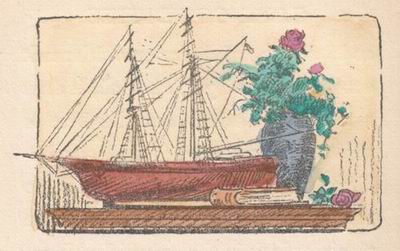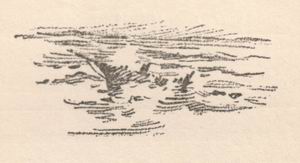| Copyright, Kellscraft Studio 1999-2003 (Return to Web Text-ures) |
Click
Here to return to Cape Coddities Content Page Click here to return to Previous Chapter |
 (HOME) |
| Copyright, Kellscraft Studio 1999-2003 (Return to Web Text-ures) |
Click
Here to return to Cape Coddities Content Page Click here to return to Previous Chapter |
 (HOME) |
 X MODELS LONG before the Old Colony Railroad thought of running a line to Cape Cod -- although that in itself was not so very long ago, well within the memory of man -- there was one charm of the Cape which is fast vanishing and entirely unknown to the casual visitor and unappreciated by the perennial summer residents. In those days there was a host of rugged, sturdy men, intelligent, courageous, upright, and keen-minded. They were the Cape captains, the men who grew up among the sand-dunes, to the rote of the sea. The men who carried the good name of Cape Cod to the ends of the earth and who brought back with them the fortunes which made the little towns, dotted here and there along the shore, havens of comfort and rest. Such men could tell stories which would vie with those of Conrad and Stevenson, but for the most part their deeds go unrecorded except in their ships' logs, for they were a simple, reserved company. Of this epoch there remains but one relic which is sought after by the present generation, and it savors of the antique. In fact, it is the antiquarian rather than the adventurer who ransacks the Cape at present for ships' models. In those early days there were months at a. time, when the ship's company were idle, and it grew to be a custom for those clever with their hands to fashion models of the schooners in which they sailed or of sea-craft notable for beauty of line or complexity of rig. Many an old sea captain would pass his idle moments in fashioning these miniature boats, and many members of the ships' crews became adept at the hobby, for a knowledge of tools was almost an essential for every man on the Cape, where the trades of carpenter, painter, and plumber were generally performed by the householder. Furthermore, a sailor would infinitely prefer to whittle out a model than to swab down the deck, and frequently a clever mechanic would be relieved by his captain from this menial work, if he devoted his time to the perfection of a model which was destined for the mantel of the captain's best parlor. Therefore, in the old days, there was scarcely 'a Cape family of saltwater ancestry which did not boast of at least one model and often more, the trademark of an honorable and hazardous occupation and a relic of former days of plenty when the Cape was peopled only by the native Cape-Codders and before steam took from them the vocation to which they were reared. To-day the captain of a full-rigged ship is as hard to find as the vessel herself, and the Cape exists upon the summer residents and upon the less productive occupation of fishing, which is largely in the hands of the Portuguese, who have come in droves to settle upon our land of Bartholomew Gosnold and his company of adventurers. And so the interest in ships and in tales of the sea has disappeared along with those who upheld the trade; and the models, familiar sights to the descendants, have been relegated to the attic or have been sold as curiosities to the ubiquitous dealers in antiques, who persistently come to the Cape for old furniture, pewter, china--anything, in fact, which can be palmed off on that voracious type of collector, the lover of antiques. During the last few years, for some reason or other, these models have become very popular. Just why it is not easy to explain. It is true that they typify a lost trade which was full of adventure. It is also true that they are decorative, many of them, but that hardly explains the ravenous appetite which many collectors of antiques have recently developed to obtain a genuine model. Dealers have secured agents in every town on the Cape who are ransacking their neighborhoods for models, half-models, pictures of boats made in bas-reliefs, weather vanes in the shape of ships, and the prices are increasing by leaps and bounds. In fact, so popular has this fad become that ex-sailors and carpenters with some slight acquaintance with the sea are now developing quite a business in fashioning models of special designs or of former famous ships. A few years ago the model of a schooner about two feet in length fully rigged would bring in the neighborhood of twenty-five dollars; to-day the same model could not be secured for less than one hundred dollars. Often the smaller, more exquisitely made specimens will bring more. The descendants of the old captains have lost any sentimental regard for these relics and gladly part with them for a comparatively small sum, but only to the patient and skillful, who know Cape ways and Cape people, and so it is almost impossible for the tourist to secure a model except from a dealer. Should the casual summer visitor attempt to bargain with his native Cape neighbor, he would find him a wily bird, suspicious of being imposed upon and as likely as not to put an absurd valuation upon his possession; and yet that same Cape neighbor might part with the model the next day to a total stranger for a smaller sum, for such is the nature of the denizen of the Cape. This contrary-mindedness and disinclination to do a favor is not unusual, but as against this trait, he will be found to be a genial host and a kindly acquaintance often generous beyond his means. And so to-day we witness the passing of the models, last relic of the olden days, the golden days of Cape Cod, from those tiny Cape cottages built by these same sturdy sea captains to the comfortable mansions of the summer people whose knowledge of the sea is secured in July and August by an occasional dip, a sail in a knock-about, and a glimpse of a glorious sunset over the shining waters of the Atlantic Ocean.  |